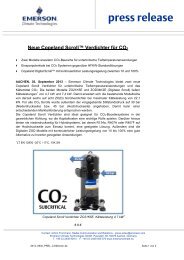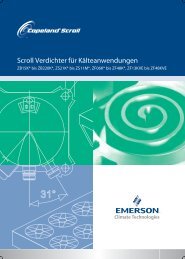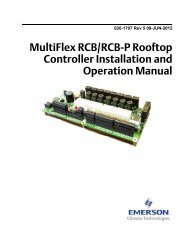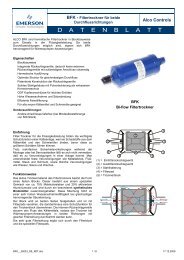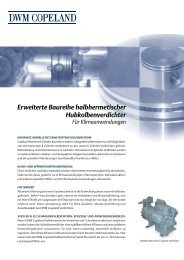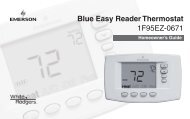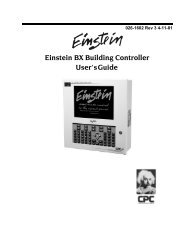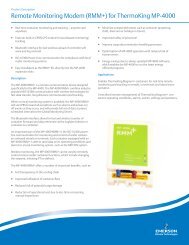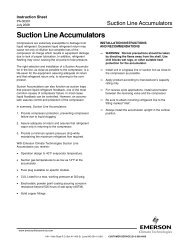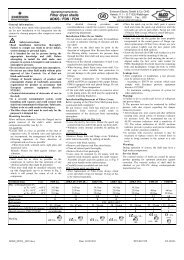Technical Information - Emerson Climate Technologies
Technical Information - Emerson Climate Technologies
Technical Information - Emerson Climate Technologies
Create successful ePaper yourself
Turn your PDF publications into a flip-book with our unique Google optimized e-Paper software.
<strong>Technical</strong> <strong>Information</strong><br />
Date of last update: Nov-08<br />
Ref: CC7.26.2/0908-1108/E<br />
Application Engineering Europe<br />
REFRIGERANT CHANGEOVER<br />
HCFC R22 TO HFC R422A/D<br />
WARNING<br />
Use only <strong>Emerson</strong> <strong>Climate</strong> <strong>Technologies</strong> approved refrigerants and lubricants in the manner<br />
prescribed by <strong>Emerson</strong> <strong>Climate</strong> <strong>Technologies</strong>.<br />
In some circumstances, other refrigerants and lubricants may be dangerous and could cause<br />
fires, explosions or electrical shorting. Contact <strong>Emerson</strong> <strong>Climate</strong> <strong>Technologies</strong> Application<br />
Engineering for more information.<br />
<strong>Emerson</strong> <strong>Climate</strong> <strong>Technologies</strong> does not advocate the wholesale changeover of HCFCs to HFCs. If a system is not<br />
leaking refrigerant to the atmosphere and is operating properly, there is no technical reason to replace the HCFC<br />
refrigerant. However, once the decision has been made to make the change from HCFC R22 to HFC R422A/D, the<br />
following guidelines are recommended.<br />
The following guidelines apply to Copeland® brand compressors.<br />
1 Considerations when retrofitting<br />
1. Retrofitting systems that employ compressors manufactured prior to 1980 is not recommended. This is due to<br />
the different materials used in motor insulation that have not been evaluated for compatibility with the new<br />
refrigerants and lubricants.<br />
2. HFC refrigerants have generally required the use of polyolester (POE) lubricants in order to ensure oil return.<br />
However, R422A/D contains a small percentage of isobutene that promotes adequate oil return in most<br />
properly piped systems with oil separators and no change-out of the mineral oil or alkybenze is required. Minor<br />
equipment modifications such as replacement or adjustment of the expansion device may be required in some<br />
applications.<br />
Oil return is determined by a number of design and operating conditions. In some systems a certain amount of<br />
POE may need to be added to assist in oil return.<br />
While R422A/D will operate properly with an oil charge of 100% POE, the POE can dislodge debris in older<br />
systems requiring liquid line filter drier change-outs to keep the system free of this debris.<br />
3. The system capacity and efficiency will be somewhat different with R422A/D than with R22. In most multiple<br />
compressor racks, there should still be adequate capacity. However, it is strongly recommended that system<br />
capacity verification be done using the refrigerant manufacturer published comparison factors.<br />
The MOC (Maximum Operating Current) values for R422A/D are higher than those for R22. The values are<br />
similar for those of R404A. The sizing of wires, contactors and breakers should be checked to ensure that they<br />
are adequate.<br />
4. R422A/D can be used in either low or medium temperature systems. R422A/D should not be mixed with any<br />
other refrigerant!<br />
5. When retrofitting from R22 to R422A the expansion valves will need to be replaced with a valve suitable for<br />
R404A. In some cases only the power element of the expansion valve can be changed, but where this is not<br />
possible the entire valve must be replaced with the equivalent capacity R404A model.<br />
When retrofitting from R22 to R422D the expansion valve capacities will be reduced by 30 to 35% and will<br />
need to be replaced.<br />
1/3
<strong>Technical</strong> <strong>Information</strong><br />
CC7.26.2/0908-1108/E<br />
6. Filter-driers must be changed at the time of conversion with filtration levels conforming to DIN8949 or with an<br />
equilibrium point of dryness (EPD) of 50 PPM or lower.<br />
• Solid core driers such as <strong>Emerson</strong> <strong>Climate</strong> <strong>Technologies</strong> ADK are compatible with either R22 or<br />
R422A/D.<br />
• Compacted bead type driers such as the <strong>Emerson</strong> <strong>Climate</strong> <strong>Technologies</strong> FDB series are also compatible.<br />
• Loose fill type driers are not recommended and should be replaced with the types referenced above.<br />
7. Pressure regulators may have to be reset. Contact the manufacturer for the correct settings.<br />
8. R422A/D exhibit higher pressures than R22 at normal condensing temperatures. This may require that the<br />
high-pressure safety controls be reset in order to operate as intended.<br />
9. Systems that use a low-pressure controller to maintain space temperature may need to have the cut in and cut<br />
out points changed. Although R422A/D does exhibit “glide”, the average evaporator or condenser temperature<br />
is within 0.27ºC of the saturated vapour temperature; therefore no correction is required.<br />
10. Systems using R422A/D should have approximately the same system pressure drop as with R22. Check with<br />
the manufacturer of any pressure regulators and pilot-operated solenoid valves used in the system to be sure<br />
that they will operate properly.<br />
11. Some compressor seals and gaskets may be affected by the removal phase of R22 during the changeover to<br />
R422A/D. Experience has shown that sight glass and terminal plate rubber elastomers are the most sensitive<br />
and should be checked.<br />
Many other system seals such as elastomeric seals, gaskets, and valve packing may be affected by the<br />
changeover from R22 to R422A/D. The part manufacturer should be contacted for their recommendations as to<br />
whether the seals need to be changed or replaced.<br />
NOTE: R422A/D is NOT compatible with the seal material used in the R22 Moduload Capacity Control<br />
system of D3D compressors. If your system has Moduload, the valve plate assembly MUST be changed.<br />
Consult your <strong>Emerson</strong> <strong>Climate</strong> <strong>Technologies</strong> wholesaler for the correct part numbers.<br />
2 Changeover procedure<br />
Before starting the changeover, at least the following items should be readily available:<br />
• Safety glasses<br />
• Gloves<br />
• Refrigerant service gauges<br />
• Electronic thermometer<br />
• Vacuum pump capable of pulling 0.3 mbar<br />
• Thermocouple micron gauge<br />
• Leak detector<br />
• Refrigerant recovery unit including refrigerant cylinder<br />
• Proper container for removed lubricant<br />
• New liquid control device<br />
• Replacement liquid line filter-drier(s)<br />
• New POE lubricant, when needed<br />
• R422A/D pressure temperature chart<br />
• R422A/D refrigerant<br />
1. Before starting the conversion, the system should be thoroughly leak tested with the R22 refrigerant still in the<br />
system. All leaks should be repaired before the R422A/D refrigerant is added.<br />
2. It is advisable that the system operating conditions (particularly the suction and discharge absolute pressures<br />
(pressure ratio) and suction superheat at the compressor inlet) be recorded with the R22 still in the system.<br />
This will provide the base data for comparison when the system is put back into operation with the R422A/D.<br />
3. Disconnect electrical power to system.<br />
4. Properly remove the R22 from the compressor. Measure and note the amount removed.<br />
5. Replace the liquid line filter-drier with one that is compatible with R422A/D.<br />
2/3
<strong>Technical</strong> <strong>Information</strong><br />
CC7.26.2/0908-1108/E<br />
6. Replace the expansion valve or power element to a model approved for R404A (only required when retrofitting<br />
from R22 to R422A).<br />
7. Evacuate the system to 0.3 mbar. A vacuum decay test is suggested to assure the system is dry and leak<br />
free.<br />
8. Recharge the system with R422A/D.<br />
9. Charge the system with R422A/D. Charge to 90% of the refrigerant removed in item 4. R422A/D must leave<br />
the charging cylinder in the liquid phase. It is suggested that a sight glass be connected between the charging<br />
hose and compressor suction service valve. This will permit adjustment of the cylinder valve to assure the<br />
refrigerant enters the compressor in the vapour state.<br />
10. Operate the system. Record the data and compare to the data taken in item 2. Check and adjust the TEV<br />
superheat setting if necessary. Make adjustments to other controls as needed. Additional R422A/D may have<br />
to be added to obtain optimum system performance.<br />
11. Properly label the components. Tag the compressor with the refrigerant used (R422A/D) and the lubricant<br />
used.<br />
CAUTION: These guidelines are intended for use with R422A/D only. Other refrigerants may not be compatible<br />
with the materials used in our compressors or the lubricants recommended in this bulletin resulting in unacceptable<br />
reliability and durability of the compressor.<br />
The information contained herein is based on technical data and tests which we believe to be reliable and is<br />
intended for use by persons having technical skill, at their own discretion and risk.<br />
Since conditions of use are beyond the control of <strong>Emerson</strong> <strong>Climate</strong> <strong>Technologies</strong>, we can assume no liability for<br />
results obtained or damages incurred through the application of the data presented.<br />
3/3



